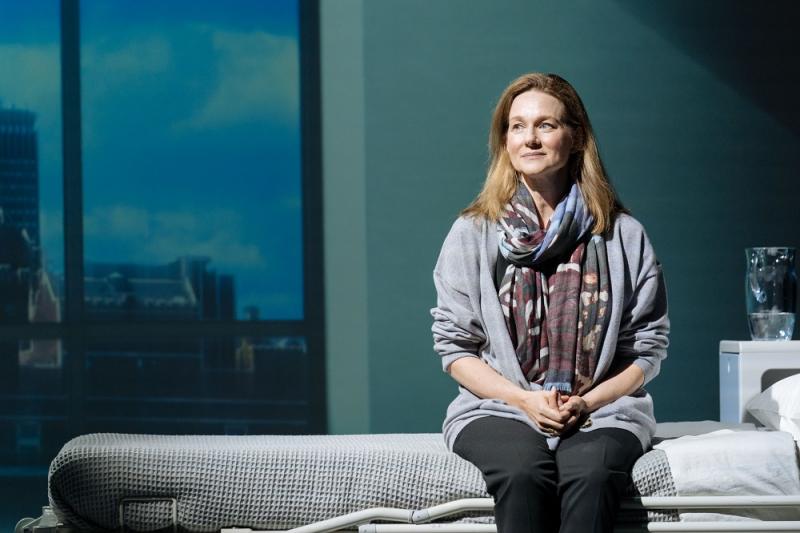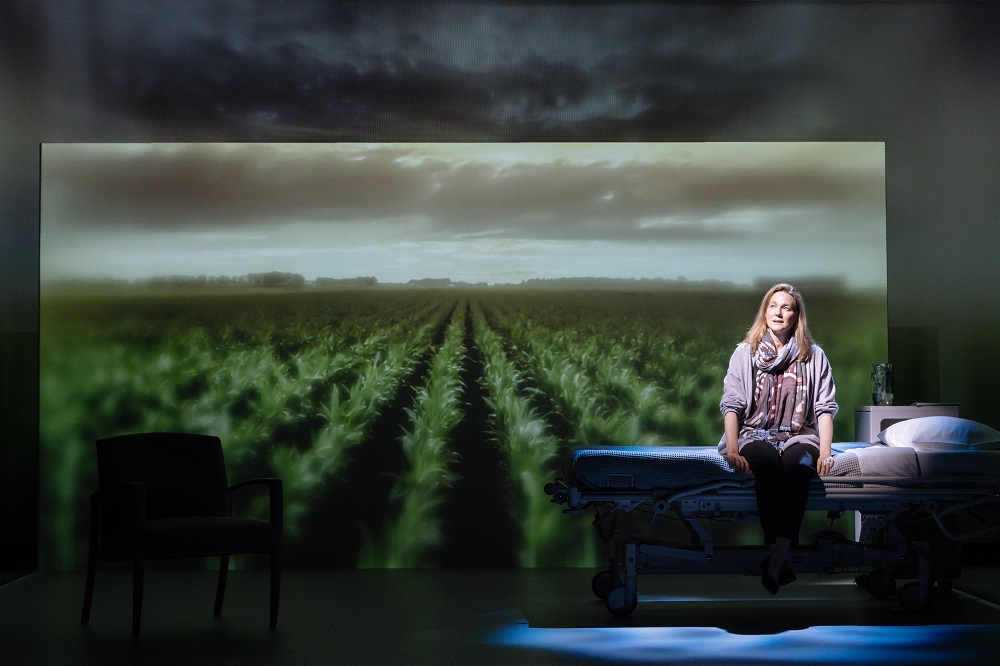My Name is Lucy Barton, Bridge Theatre review - Laura Linney is luminous in a flawless production | reviews, news & interviews
My Name is Lucy Barton, Bridge Theatre review - Laura Linney is luminous in a flawless production
My Name is Lucy Barton, Bridge Theatre review - Laura Linney is luminous in a flawless production
Stage adaptation of Elizabeth Strout's novel is a one-woman tour de force

In Harold Pinter’s memory play Old Times, one of the women declares, “There are some things one remembers even though they may never have happened.” Elizabeth Strout’s heroine in My Name Is Lucy Barton is in the reverse position. When it comes to the difficult childhood she has long since escaped, she’s uncertain of what she can – or wants to – remember, yet she is anything but the standard issue unreliable narrator.
Part of Strout’s achievement in her immensely well-regarded 2016 novel is her creation and control of so vivid a tone of voice for her eponymous narrator, Lucy Barton. On the surface the “plot” is simple: Lucy tells the story of a nine-week stay she had, years ago, in a New York midtown hospital in which, to her surprise, she was visited by her mother whom she had not seen in years. The visit was in the 1980s when Lucy feels she was a different woman from the one she is now. What was it that she did or didn’t understand back then? Who is responsible for the development of her emotions, her fears and her future as a writer?
Female confrontation across the generations is a Hollywood staple from Mildred Pierce through Mommie, Dearest to Terms of Endearment and beyond, but this is no mother/daughter smackdown cliché. Both the book and the play are exquisitely quiet, unfashionably calm and utterly riveting. Cheap emotional climaxes are replaced by a slowly unfurling, properly complicated portrait of a woman who wants to understand the relationships that, for better and worse, formed her.
Most stories are slow to start but Eyre paces the opening with such impressively focused energy that you don’t notice how necessarily expository much of the initial material is. And with Linney immediately so seemingly relaxed and in command of her character’s present and past, she simply wins over the audience without ever stooping to woo them. Achieving that on the wide open space of Bob Crowley’s elegant, grey open stage with audiences wrapped round on three sides is particularly impressive. Linney and Eyre refuse to anticipate or foreshadow troubles ahead. Even John Leonard’s soundscape – one part realistic sound effects to one part woozy instrumental writing – resists the temptation to nudge the audience towards a specific mood. This, mercifully, is not a production in which heavily signalling underscoring mistakes subtext for the text itself. But then the entire production team pays the audience the compliment of believing they can concentrate hard enough to fill in the carefully constructed gaps in the consummately skilled telling and, crucially, the tale itself. What exactly did go on in Lucy’s dirt-poor home? Why is her father so removed from the story? Why the estrangement from her siblings?
Linney and Eyre refuse to anticipate or foreshadow troubles ahead. Even John Leonard’s soundscape – one part realistic sound effects to one part woozy instrumental writing – resists the temptation to nudge the audience towards a specific mood. This, mercifully, is not a production in which heavily signalling underscoring mistakes subtext for the text itself. But then the entire production team pays the audience the compliment of believing they can concentrate hard enough to fill in the carefully constructed gaps in the consummately skilled telling and, crucially, the tale itself. What exactly did go on in Lucy’s dirt-poor home? Why is her father so removed from the story? Why the estrangement from her siblings?
A lesser writer would have come up with The Big Reveal – a moment of understanding and reversal – but Strout is much more ambitious. She’s interested less in what we know about our past than in what and how we guess, what we discern and how we draw upon pain to lead our lives.
With the narrator already so present in the novel, it is no disrespect to say that, on the surface, Munro’s job is closer to that of an editor than a dramatist. Yet she has reordered and distilled the material perfectly to allow an actor to inhabit both the character and the play’s ideas. Seizing the text and mining it for truth, Linney also finds plenty of space for humour, both self-deprecating and as a device for humanising her withholding, ruthless unsentimental mother. She amusingly shows the latter by simply compressing her body, finding taut physical angles alongside a pinched sound and comically strong Illinois accent.
One final element holds everything in perfect balance. Peter Mumford’s lighting not only controls the space but with his highly expressive use of colour – eerie deep blue, warm purple, near-amber sunlight – he quietly sets the emotional temperature for scenes located by Luke Halls’ quasi-literal, beautifully abstracted video designs showing, say, the cornfields of home and the Chrysler building outside Lucy’s hospital window. Video is often overly dominant in contemporary design but Halls and Eyre ensure images surreptitiously melt and flow, thus allowing Mumford the latitude to intensify mood and emotion while always allowing Linney to lead the scene.
What impresses most is Linney’s timing and the meticulous placing of detail. Throughout the intermissionless 90 minutes, you feel you are being spoken to, never spoken at. Linney’s stillness alone makes this one of the finest, least “actorly" performances in town.
rating
Explore topics
Share this article
The future of Arts Journalism
You can stop theartsdesk.com closing!
We urgently need financing to survive. Our fundraising drive has thus far raised £49,000 but we need to reach £100,000 or we will be forced to close. Please contribute here: https://gofund.me/c3f6033d
And if you can forward this information to anyone who might assist, we’d be grateful.

Subscribe to theartsdesk.com
Thank you for continuing to read our work on theartsdesk.com. For unlimited access to every article in its entirety, including our archive of more than 15,000 pieces, we're asking for £5 per month or £40 per year. We feel it's a very good deal, and hope you do too.
To take a subscription now simply click here.
And if you're looking for that extra gift for a friend or family member, why not treat them to a theartsdesk.com gift subscription?
more Theatre
 Macbeth, RSC, Stratford review - Glaswegian gangs and ghoulies prove gripping
Sam Heughan's Macbeth cannot quite find a home in a mobster pub
Macbeth, RSC, Stratford review - Glaswegian gangs and ghoulies prove gripping
Sam Heughan's Macbeth cannot quite find a home in a mobster pub
 The Line of Beauty, Almeida Theatre review - the 80s revisited in theatrically ravishing form
Alan Hollinghurst novel is cunningly filleted, very finely acted
The Line of Beauty, Almeida Theatre review - the 80s revisited in theatrically ravishing form
Alan Hollinghurst novel is cunningly filleted, very finely acted
 Wendy & Peter Pan, Barbican Theatre review - mixed bag of panto and comic play, turned up to 11
The RSC adaptation is aimed at children, though all will thrill to its spectacle
Wendy & Peter Pan, Barbican Theatre review - mixed bag of panto and comic play, turned up to 11
The RSC adaptation is aimed at children, though all will thrill to its spectacle
 Hedda, Orange Tree Theatre review - a monument reimagined, perhaps even improved
Scandinavian masterpiece transplanted into a London reeling from the ravages of war
Hedda, Orange Tree Theatre review - a monument reimagined, perhaps even improved
Scandinavian masterpiece transplanted into a London reeling from the ravages of war
 The Assembled Parties, Hampstead review - a rarity, a well-made play delivered straight
Witty but poignant tribute to the strength of family ties as all around disintegrates
The Assembled Parties, Hampstead review - a rarity, a well-made play delivered straight
Witty but poignant tribute to the strength of family ties as all around disintegrates
 Mary Page Marlowe, Old Vic review - a starry portrait of a splintered life
Tracy Letts's Off Broadway play makes a shimmeringly powerful London debut
Mary Page Marlowe, Old Vic review - a starry portrait of a splintered life
Tracy Letts's Off Broadway play makes a shimmeringly powerful London debut
 Little Brother, Soho Theatre review - light, bright but emotionally true
This Verity Bargate Award-winning dramedy is entertaining as well as thought provoking
Little Brother, Soho Theatre review - light, bright but emotionally true
This Verity Bargate Award-winning dramedy is entertaining as well as thought provoking
 The Unbelievers, Royal Court Theatre - grimly compelling, powerfully performed
Nick Payne's new play is amongst his best
The Unbelievers, Royal Court Theatre - grimly compelling, powerfully performed
Nick Payne's new play is amongst his best
 The Maids, Donmar Warehouse review - vibrant cast lost in a spectacular-looking fever dream
Kip Williams revises Genet, with little gained in the update except eye-popping visuals
The Maids, Donmar Warehouse review - vibrant cast lost in a spectacular-looking fever dream
Kip Williams revises Genet, with little gained in the update except eye-popping visuals
 Ragdoll, Jermyn Street Theatre review - compelling and emotionally truthful
Katherine Moar returns with a Patty Hearst-inspired follow up to her debut hit 'Farm Hall'
Ragdoll, Jermyn Street Theatre review - compelling and emotionally truthful
Katherine Moar returns with a Patty Hearst-inspired follow up to her debut hit 'Farm Hall'
 Troilus and Cressida, Globe Theatre review - a 'problem play' with added problems
Raucous and carnivalesque, but also ugly and incomprehensible
Troilus and Cressida, Globe Theatre review - a 'problem play' with added problems
Raucous and carnivalesque, but also ugly and incomprehensible
 Clarkston, Trafalgar Theatre review - two lads on a road to nowhere
Netflix star, Joe Locke, is the selling point of a production that needs one
Clarkston, Trafalgar Theatre review - two lads on a road to nowhere
Netflix star, Joe Locke, is the selling point of a production that needs one

Add comment